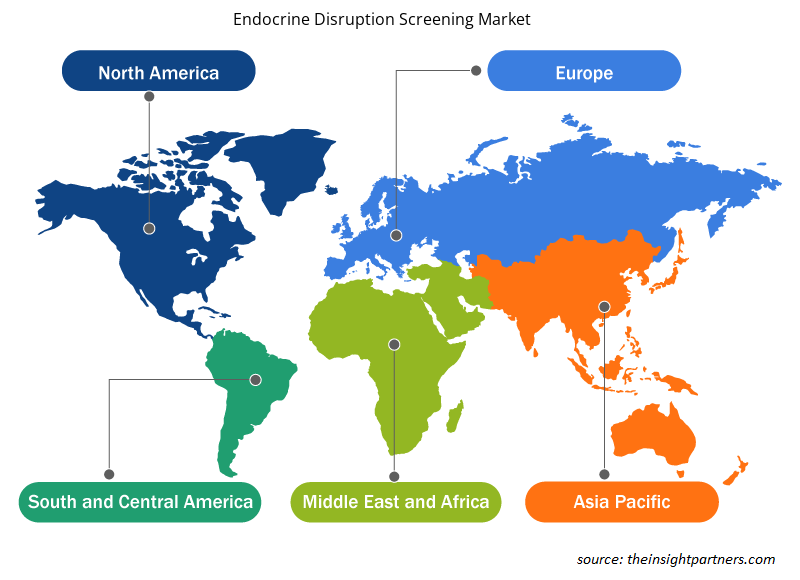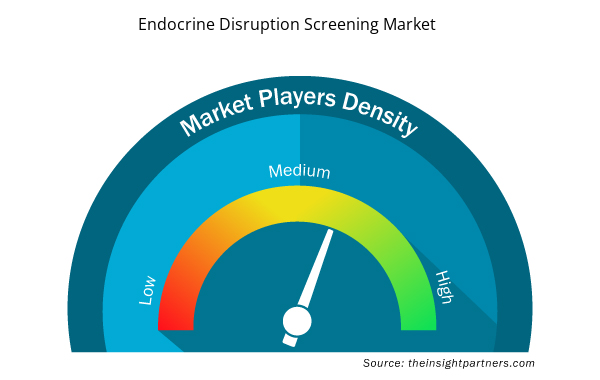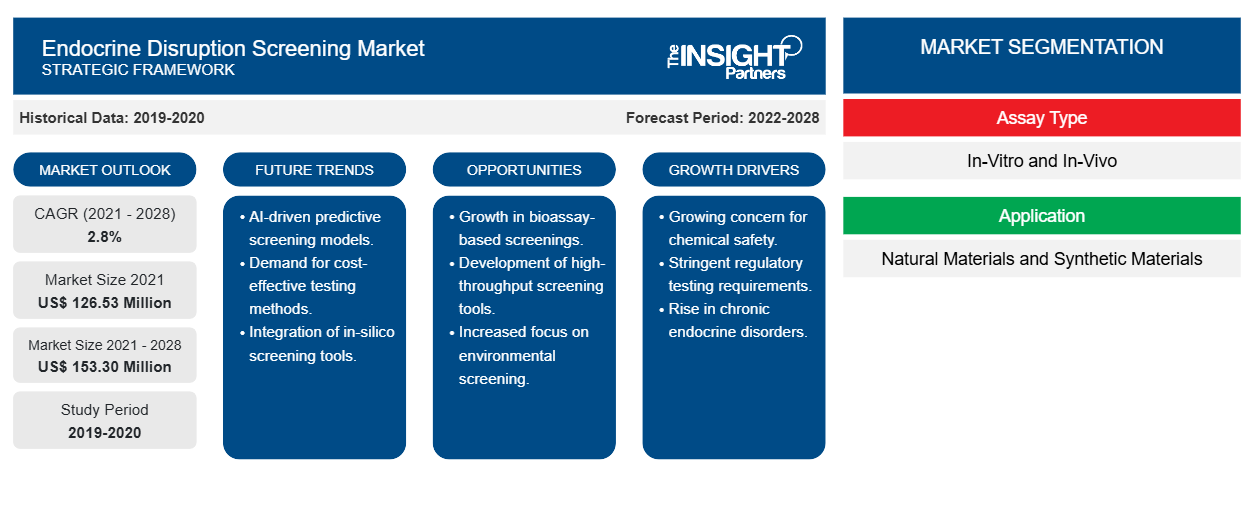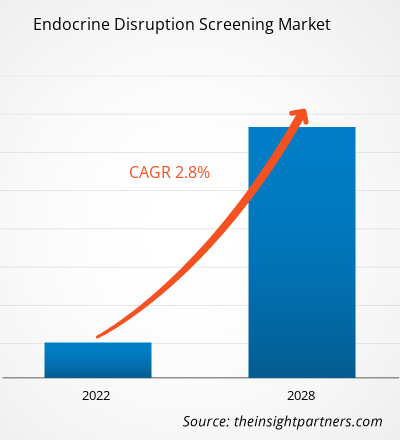内分泌干扰筛查市场规模预计将从 2021 年的 1.2653 亿美元增至 2028 年的 1.533 亿美元;预计 2021 年至 2028 年期间的复合年增长率为 2.8%。
许多化学物质,无论是天然的还是人造的,都有可能模仿或干扰调节人体激素的内分泌系统。这些被称为内分泌干扰物的化学物质与发育、生殖、大脑、免疫和其他疾病有关。内分泌干扰物可能存在于各种普通物品中,例如一些塑料瓶和容器、金属食品罐内衬、洗涤剂、阻燃剂、食品、玩具、化妆品和杀虫剂。内分泌干扰物筛选使用两层方法筛选杀虫剂、化学品和环境毒素,以确定它们对雌激素、雄激素和甲状腺激素系统的潜在影响。
内分泌紊乱筛查市场的增长得益于生物技术领域研究的不断深入以及内分泌紊乱患病率的不断上升。然而,筛查技术成本过高阻碍了市场的增长。
定制此报告以满足您的需求
您可以免费定制任何报告,包括本报告的部分内容、国家级分析、Excel 数据包,以及为初创企业和大学提供优惠和折扣
- 获取此报告的关键市场趋势。这个免费样品将包括数据分析,从市场趋势到估计和预测。
市场洞察
内分泌失调患病率不断上升推动内分泌干扰筛查市场
肢端肥大症(生长激素分泌过剩)、肥胖症、代谢综合征、空腹血糖受损、糖耐量受损、骨质疏松症、骨质减少、轻度至中度维生素 D 缺乏症、勃起功能障碍、血脂异常和甲状腺炎是美国成年人中总体患病率至少为 5% 的内分泌疾病。在这些疾病中,男性勃起功能障碍的发病率最高,而女性骨质减少/骨质疏松症的发病率最高。儿童糖尿病和垂体腺瘤是最不常见的疾病,影响不到 1% 的美国人口。肾上腺皮质癌、嗜铬细胞瘤和垂体腺瘤是发病率最低的疾病。甲状旁腺功能亢进症和甲状腺疾病在女性中更常见。糖尿病在少数民族中最为常见。内分泌和代谢疾病是现代人类最常见的疾病之一,尤其是在美国和其他为高危人群实施充足营养和筛查计划的国家。甲状旁腺功能亢进、原发性和继发性性腺功能低下、生长激素缺乏症和甲状腺功能减退等内分泌疾病可导致其他疾病,如代谢性骨病和糖尿病。因此,此类疾病的患病率和发病率不断上升,推动了对内分泌干扰筛查产品的需求。
基于检测类型的洞察
根据检测类型,内分泌干扰筛查市场分为体外和体内两类。体外部分在 2021 年占据市场主导地位,贡献了 64.45% 的市场份额,预计在预测期内将保持主导地位,占 2028 年总收入的 65.73% 的市场份额。
基于应用的洞察
根据应用,内分泌干扰筛查市场分为天然材料和合成材料。2021 年,天然材料领域占据了更大的市场份额。此外,预计 2021-2028 年同一领域的市场复合年增长率将达到 3.1%。
基于废弃物的洞察来源
根据废物来源,内分泌干扰筛查市场分为焚烧和填埋、农业径流、工业和市政污水、纸浆厂污水、消费品等。2021 年,焚烧和填埋部分占据了最大的市场份额。此外,预计同一细分市场的市场在 2021-2028 年期间将以 3.5% 的复合年增长率增长。
基于方法的见解
内分泌干扰筛查市场按方法细分为雌激素受体 (ER) 反式激活、雄激素受体 (AR) 反式激活、雄激素受体 (AR) 调节、雌激素受体-α (ER) 结合、雌激素受体 β (ER) 结合、雄激素受体 (AR) 结合、类固醇生成、芳香化酶测定等。2021 年,雌激素受体 (ER) 反式激活细分市场占据了最大的市场份额。此外,预计从 2021 年到 2028 年,同一细分市场的复合年增长率将达到 3.7%,为最快的增长。
基于最终用户的洞察
根据最终用途,内分泌干扰筛查市场分为制药和生物制药公司、化妆品和家用产品公司、食品行业和化学行业。2021 年,制药和生物制药公司占据了最大的市场份额。此外,预计 2021-2028 年期间,同一细分市场的复合年增长率将达到 3.3%,为最快的增长。
产品发布和审批是公司扩大全球业务和产品组合的常用策略。此外,内分泌干扰筛查市场参与者专注于合作策略来扩大客户群,这反过来又使他们能够在全球范围内保持自己的品牌名称。
内分泌干扰筛查市场区域洞察
Insight Partners 的分析师已详尽解释了预测期内影响内分泌干扰筛查市场的区域趋势和因素。本节还讨论了北美、欧洲、亚太地区、中东和非洲以及南美和中美洲的内分泌干扰筛查市场细分和地理位置。

- 获取内分泌干扰筛查市场的区域特定数据
内分泌干扰筛查市场报告范围
| 报告属性 | 细节 |
|---|---|
| 2021 年市场规模 | 1.2653亿美元 |
| 2028 年市场规模 | 1.533亿美元 |
| 全球复合年增长率(2021 - 2028) | 2.8% |
| 史料 | 2019-2020 |
| 预测期 | 2022-2028 |
| 涵盖的领域 | 按检测类型
|
| 覆盖地区和国家 | 北美
|
| 市场领导者和主要公司简介 |
|
市场参与者密度:了解其对商业动态的影响
内分泌干扰筛查市场正在快速增长,这得益于终端用户需求的不断增长,而这些需求又源于消费者偏好的不断变化、技术进步以及对产品优势的认识不断提高等因素。随着需求的增加,企业正在扩大其产品范围,进行创新以满足消费者的需求,并利用新兴趋势,从而进一步推动市场增长。
市场参与者密度是指在特定市场或行业内运营的企业或公司的分布情况。它表明相对于给定市场空间的规模或总市场价值,有多少竞争对手(市场参与者)存在于该市场空间中。
在内分泌干扰筛查市场运营的主要公司有:
- 创意生物阵列
- 德国XENOMETRIX公司
- 查尔斯河
- 欧陆科学
- 史密瑟斯
免责声明:上面列出的公司没有按照任何特定顺序排列。

- 了解内分泌干扰筛查市场主要参与者概况
报告将内分泌干扰筛查市场细分如下
内分泌干扰筛查市场 – 按检测类型划分
- 体外
- 体内
内分泌干扰筛查市场——按应用划分
- 天然材料
- 合成材料
内分泌干扰筛查市场 – 按废物来源划分
- 焚烧和填埋
- 农业径流
- 工业和市政污水
- 纸浆厂废水
- 消费产品
- 其他的
内分泌干扰筛查市场 – 按方法分类
- 雌激素受体 (ER) 反式激活
- 雄激素受体 (AR) 转录激活
- 雄激素受体 (AR) 调节
- 雌激素受体-α (ER-α) 结合
- 雌激素受体 β (ER-β) 结合
- 雄激素受体 (AR) 结合
- 类固醇生成
- 芳香化酶测定
- 其他的
内分泌干扰筛查市场 – 按最终用户划分
- 制药和生物制药公司
- 化工
- 食品工业
- 化妆品和家居用品公司
内分泌干扰筛查市场 – 按地区划分
- 北美
- 我们
- 加拿大
- 墨西哥
- 欧洲
- 英国
- 德国
- 法国
- 意大利
- 西班牙
- 欧洲其他地区
- 亚太地区
- 中国
- 日本
- 印度
- 澳大利亚
- 韩国
- 亚太其他地区
- 中东和非洲
- 阿联酋
- 沙特阿拉伯
- 南非
- 中东和非洲其他地区
- 南美洲和中美洲
- 巴西
- 阿根廷
- 南美洲和中美洲其他地区
公司简介
- 创意生物阵列
- 德国XENOMETRIX公司
- 查尔斯河实验室有限公司
- EUROFINS SCIENTIFIC 有限公司
- 史密瑟斯
- 瑞士通用公证行
- JRF全球
- 梅里埃营养科学
- 阿尔法分析有限公司
- 历史分析(2 年)、基准年、预测(7 年)及复合年增长率
- PEST 和 SWOT 分析
- 市场规模价值/数量 - 全球、区域、国家
- 行业和竞争格局
- Excel 数据集



Report Coverage
Revenue forecast, Company Analysis, Industry landscape, Growth factors, and Trends

Segment Covered
This text is related
to segments covered.

Regional Scope
North America, Europe, Asia Pacific, Middle East & Africa, South & Central America

Country Scope
This text is related
to country scope.
常见问题
The global endocrine disruption screening market is expected to reach US$ 153.30 million by 2028 from US$ 126.53 million in 2021. The market is estimated to grow with a CAGR of 2.8% from 2021-2028.
Regulatory agencies throughout the world are grappling with the task of assessing the hazards and dangers to human and ecosystem health that may come from exposure to substances that disrupt the normal functioning of endocrine systems. The rapidly rising number of compounds in commerce, along with the dependence on conventional, expensive animal tests for hazard assessment – frequently with insufficient sensitivity to many critical processes of endocrine disruption – poses persistent problems for chemical management. As a result, there are only a few compounds for which there is enough evidence to determine whether there is endocrine toxicity, and hence only a few substances with full hazard categorization. To address this issue, regulatory assessment of endocrine disrupting chemicals (EDCs) is benefiting from a toxicology revolution focused on New Approach Methodologies (NAMs) to more rapidly identify, prioritize, and assess the potential risks from chemical exposure using novel, more efficient, and mechanistically driven methodologies, and tools.
The Asia Pacific region is expected to be the fastest-growing region among all other regions. The market is this region is expected to grow significantly in countries such as China, Japan, South Korea, and India. The growth of the market in this region is expected to grow at a faster pace owing to factors such as high prevalence of this hormonal changes, and the rise in healthcare awareness. Additionally, developing healthcare infrastructure and increasing investments are projected to drive the Asia Pacific endocrine disruption screening market during the forecast period.
The growth of the endocrine disruption screening market is mainly attributed to factors such as the increasing prevalence of endocrine disorders coupled with rising incidence of diabetes. However, the high cost of screening technology and devices is hindering the market growth. In July 2021, DDA platform, the division of Creative Bioarray, launched a wide range of genotoxicity testing services (non-GLP) into the service segment of in vitro toxicity services which is contributing to the growth of the target market. Such strategic steps are also projected to drive the market growth.
Many chemicals, both natural and man-made, can imitate or interfere with the endocrine system, which regulates the body's hormones. These chemicals, known as endocrine disruptors, have been related to developmental, reproductive, cognitive, immunological, and other issues. Many ordinary products include endocrine disruptors, such as some plastic bottles and containers, metal food can liners, detergents, flame retardants, food, toys, cosmetics, and pesticides. Some hormone-disrupting compounds take a long time to degrade in the environment. As a result of this trait, they can become dangerous over time. Pesticides, chemicals, and environmental toxins are screened using a two-tiered method for their potential effect on the estrogen, androgen, and thyroid hormone systems by the endocrine disruptor screening.
Trends and growth analysis reports related to Life Sciences : READ MORE..
The List of Companies - Endocrine Disruption Screening Market
- CREATIVE BIOARRAY
- XENOMETRIX AG
- CHARLES RIVER
- EUROFINS SCIENTIFIC
- SMITHERS
- SGS SA
- JRF GLOBAL
- MéRIEUX NUTRISCIENCES
- ALPHA ANALYTICAL
The Insight Partners performs research in 4 major stages: Data Collection & Secondary Research, Primary Research, Data Analysis and Data Triangulation & Final Review.
- Data Collection and Secondary Research:
As a market research and consulting firm operating from a decade, we have published and advised several client across the globe. First step for any study will start with an assessment of currently available data and insights from existing reports. Further, historical and current market information is collected from Investor Presentations, Annual Reports, SEC Filings, etc., and other information related to company’s performance and market positioning are gathered from Paid Databases (Factiva, Hoovers, and Reuters) and various other publications available in public domain.
Several associations trade associates, technical forums, institutes, societies and organization are accessed to gain technical as well as market related insights through their publications such as research papers, blogs and press releases related to the studies are referred to get cues about the market. Further, white papers, journals, magazines, and other news articles published in last 3 years are scrutinized and analyzed to understand the current market trends.
- Primary Research:
The primarily interview analysis comprise of data obtained from industry participants interview and answers to survey questions gathered by in-house primary team.
For primary research, interviews are conducted with industry experts/CEOs/Marketing Managers/VPs/Subject Matter Experts from both demand and supply side to get a 360-degree view of the market. The primary team conducts several interviews based on the complexity of the markets to understand the various market trends and dynamics which makes research more credible and precise.
A typical research interview fulfils the following functions:
- Provides first-hand information on the market size, market trends, growth trends, competitive landscape, and outlook
- Validates and strengthens in-house secondary research findings
- Develops the analysis team’s expertise and market understanding
Primary research involves email interactions and telephone interviews for each market, category, segment, and sub-segment across geographies. The participants who typically take part in such a process include, but are not limited to:
- Industry participants: VPs, business development managers, market intelligence managers and national sales managers
- Outside experts: Valuation experts, research analysts and key opinion leaders specializing in the electronics and semiconductor industry.
Below is the breakup of our primary respondents by company, designation, and region:

Once we receive the confirmation from primary research sources or primary respondents, we finalize the base year market estimation and forecast the data as per the macroeconomic and microeconomic factors assessed during data collection.
- Data Analysis:
Once data is validated through both secondary as well as primary respondents, we finalize the market estimations by hypothesis formulation and factor analysis at regional and country level.
- Macro-Economic Factor Analysis:
We analyse macroeconomic indicators such the gross domestic product (GDP), increase in the demand for goods and services across industries, technological advancement, regional economic growth, governmental policies, the influence of COVID-19, PEST analysis, and other aspects. This analysis aids in setting benchmarks for various nations/regions and approximating market splits. Additionally, the general trend of the aforementioned components aid in determining the market's development possibilities.
- Country Level Data:
Various factors that are especially aligned to the country are taken into account to determine the market size for a certain area and country, including the presence of vendors, such as headquarters and offices, the country's GDP, demand patterns, and industry growth. To comprehend the market dynamics for the nation, a number of growth variables, inhibitors, application areas, and current market trends are researched. The aforementioned elements aid in determining the country's overall market's growth potential.
- Company Profile:
The “Table of Contents” is formulated by listing and analyzing more than 25 - 30 companies operating in the market ecosystem across geographies. However, we profile only 10 companies as a standard practice in our syndicate reports. These 10 companies comprise leading, emerging, and regional players. Nonetheless, our analysis is not restricted to the 10 listed companies, we also analyze other companies present in the market to develop a holistic view and understand the prevailing trends. The “Company Profiles” section in the report covers key facts, business description, products & services, financial information, SWOT analysis, and key developments. The financial information presented is extracted from the annual reports and official documents of the publicly listed companies. Upon collecting the information for the sections of respective companies, we verify them via various primary sources and then compile the data in respective company profiles. The company level information helps us in deriving the base number as well as in forecasting the market size.
- Developing Base Number:
Aggregation of sales statistics (2020-2022) and macro-economic factor, and other secondary and primary research insights are utilized to arrive at base number and related market shares for 2022. The data gaps are identified in this step and relevant market data is analyzed, collected from paid primary interviews or databases. On finalizing the base year market size, forecasts are developed on the basis of macro-economic, industry and market growth factors and company level analysis.
- Data Triangulation and Final Review:
The market findings and base year market size calculations are validated from supply as well as demand side. Demand side validations are based on macro-economic factor analysis and benchmarks for respective regions and countries. In case of supply side validations, revenues of major companies are estimated (in case not available) based on industry benchmark, approximate number of employees, product portfolio, and primary interviews revenues are gathered. Further revenue from target product/service segment is assessed to avoid overshooting of market statistics. In case of heavy deviations between supply and demand side values, all thes steps are repeated to achieve synchronization.
We follow an iterative model, wherein we share our research findings with Subject Matter Experts (SME’s) and Key Opinion Leaders (KOLs) until consensus view of the market is not formulated – this model negates any drastic deviation in the opinions of experts. Only validated and universally acceptable research findings are quoted in our reports.
We have important check points that we use to validate our research findings – which we call – data triangulation, where we validate the information, we generate from secondary sources with primary interviews and then we re-validate with our internal data bases and Subject matter experts. This comprehensive model enables us to deliver high quality, reliable data in shortest possible time.


 获取此报告的免费样本
获取此报告的免费样本